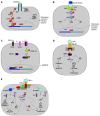Signal transduction pathways in liver and the influence of hepatitis C virus infection on their activities
- PMID: 19437557
- PMCID: PMC2682232
- DOI: 10.3748/wjg.15.2184
Signal transduction pathways in liver and the influence of hepatitis C virus infection on their activities
Abstract
In liver, the most intensively studied transmembrane and intracellular signal transduction pathways are the Janus kinase signal transduction pathway, the mitogen-activated protein kinases signal transduction pathway, the transforming growth factor beta signal transduction pathway, the tumor necrosis factor alpha signal transduction pathway and the recently discovered sphingolipid signal transduction pathway. All of them are activated by many different cytokines and growth factors. They regulate specific cell mechanisms such as hepatocytes proliferation, growth, differentiation, adhesion, apoptosis, and synthesis and degradation of the extracellular matrix. The replication cycle of hepatitis C virus (HCV) is intracellular and requires signal transduction to the nucleus to regulate transcription of its genes. Moreover, HCV itself, by its structural and non-structural proteins, could influence the activity of the second signal messengers. Thus, the inhibition of the transmembrane and intracellular signal transduction pathways could be a new therapeutic target in chronic hepatitis C treatment.
Figures

Similar articles
-
CD40 inhibits replication of hepatitis C virus in primary human hepatocytes by c-Jun N terminal kinase activation independent from the interferon pathway.Hepatology. 2013 Jan;57(1):23-36. doi: 10.1002/hep.25966. Hepatology. 2013. PMID: 22814930
-
Nonstructural 3 Protein of Hepatitis C Virus Modulates the Tribbles Homolog 3/Akt Signaling Pathway for Persistent Viral Infection.J Virol. 2016 Jul 27;90(16):7231-7247. doi: 10.1128/JVI.00326-16. Print 2016 Aug 15. J Virol. 2016. PMID: 27252525 Free PMC article.
-
Hepatitis C virus-mediated enhancement of microRNA miR-373 impairs the JAK/STAT signaling pathway.J Virol. 2015 Mar;89(6):3356-65. doi: 10.1128/JVI.03085-14. Epub 2015 Jan 14. J Virol. 2015. PMID: 25589644 Free PMC article.
-
Decoding cell death signals in liver inflammation.J Hepatol. 2013 Sep;59(3):583-94. doi: 10.1016/j.jhep.2013.03.033. Epub 2013 Apr 6. J Hepatol. 2013. PMID: 23567086 Review.
-
Hepatitis C virus infection and apoptosis.World J Gastroenterol. 2007 Sep 28;13(36):4865-72. doi: 10.3748/wjg.v13.i36.4865. World J Gastroenterol. 2007. PMID: 17828818 Free PMC article. Review.
Cited by
-
Hepatitis C virus-host interactions: Etiopathogenesis and therapeutic strategies.World J Exp Med. 2012 Apr 20;2(2):7-25. doi: 10.5493/wjem.v2.i2.7. eCollection 2012 Apr 20. World J Exp Med. 2012. PMID: 24520529 Free PMC article.
-
Metabolomic profile of hepatitis C virus-infected hepatocytes.PLoS One. 2011;6(8):e23641. doi: 10.1371/journal.pone.0023641. Epub 2011 Aug 11. PLoS One. 2011. PMID: 21853158 Free PMC article.
-
The AMPK-related kinase SNARK regulates hepatitis C virus replication and pathogenesis through enhancement of TGF-β signaling.J Hepatol. 2013 Nov;59(5):942-8. doi: 10.1016/j.jhep.2013.06.025. Epub 2013 Jul 2. J Hepatol. 2013. PMID: 23831117 Free PMC article.
References
-
- Choo QL, Kuo G, Weiner AJ, Overby LR, Bradley DW, Houghton M. Isolation of a cDNA clone derived from a blood-borne non-A, non-B viral hepatitis genome. Science. 1989;244:359–362. - PubMed
-
- Lindenbach BD, Rice CM. Flaviviridae: the viruses and their replication. In: Knipe DM, Howley PM, editors. Fields Virology. 4th edition, volume 1. Philadelphia: Lippincott-Raven Publishers; 2001. pp. 991–1041.
-
- Czepiel J, Biesiada G, Mach T. Viral hepatitis C. Pol Arch Med Wewn. 2008;118:734–740. - PubMed
-
- Shuai K. Regulation of cytokine signaling pathways by PIAS proteins. Cell Res. 2006;16:196–202. - PubMed
-
- Krebs DL, Hilton DJ. SOCS: physiological suppressors of cytokine signaling. J Cell Sci. 2000;113:2813–2819. - PubMed
MeSH terms
Substances
LinkOut - more resources
Full Text Sources

